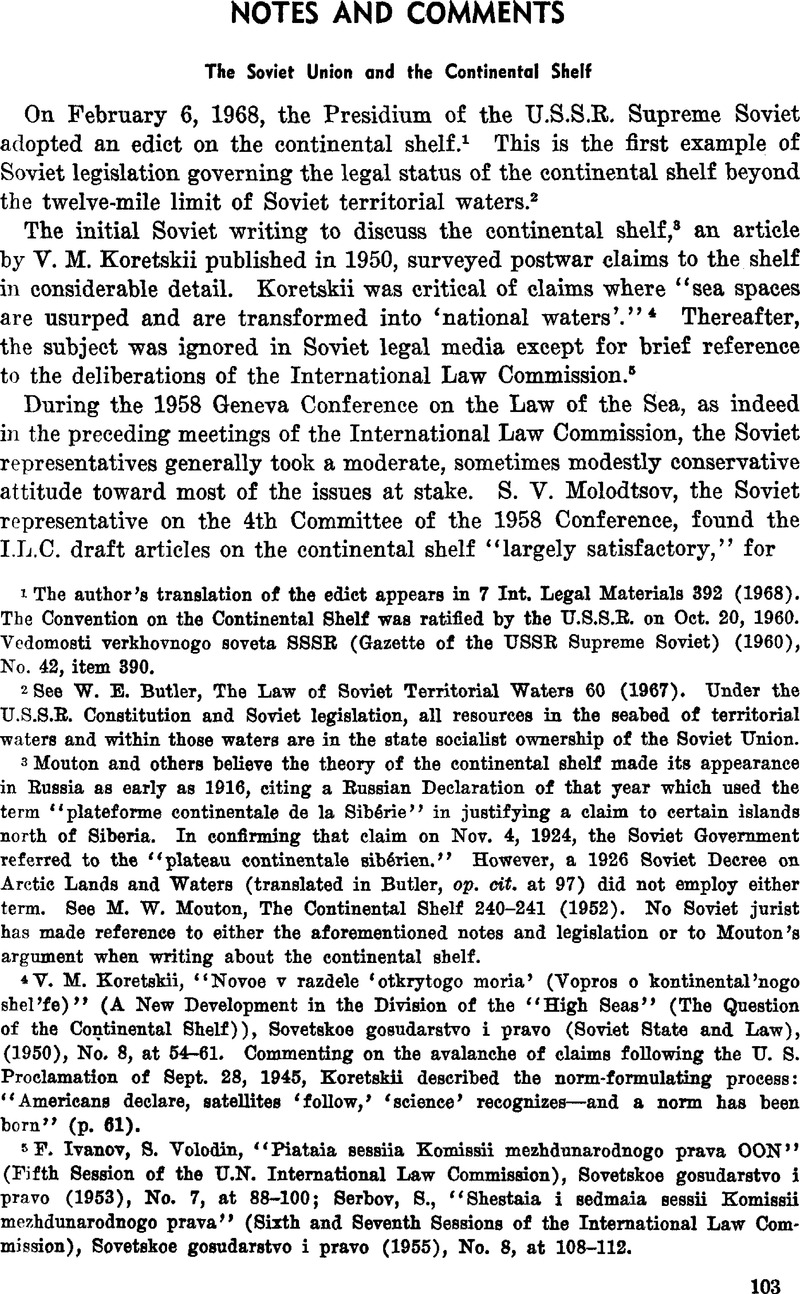Article contents
The Soviet Union and the Continental Shelf
Published online by Cambridge University Press: 28 March 2017
Abstract

- Type
- Notes and Comments
- Information
- Copyright
- Copyright © The American Society of International Law 1969
References
1 The author's translation of the edict appears in 7 Int. Legal Materials 392 (1968). The Convention on the Continental Shelf was ratified by the TJ.S.S.E. on Oct. 20, 1960. Vedomosti verkhovnogo soveta BSSE (Gazette of the USSE Supreme Soviet) (1960), No. 42, item 390.
2 See W. E. Butler, The Law of Soviet Territorial Waters 60 (1967). Under the U.B.S.E. Constitution and Soviet legislation, all resources in the seabed of territorial waters and within those waters are in the state socialist ownership of the Soviet Union.
3 Mouton and others believe the theory of the continental shelf made its appearance in Russia as early as 1916, citing a Russian Declaration of that year which used the term “plateforme continentale de la Sibfirie” in justifying a claim to certain islands north of Siberia. In confirming that claim on Nov. 4, 1924, the Soviet Government referred to the “plateau continentale siberien.” However, a 1926 Soviet Decree on Arctic Lands and Waters (translated in Butler, op. cit. at 97) did not employ either term. See M. W. Mouton, The Continental Shelf 240-241 (1952). No Soviet jurist has made reference to either the aforementioned notes and legislation or to Mouton's argument when writing about the continental shelf.
4 V. M. Koretskii, “Novoe v razdele ‘otkrytogo moria’ (Vopros o kontinental'nogo shel'fe)” (A New Development in the Division of the “High Seas” (The Question of the Continental Shelf)), Sovetakoe gosudarstvo i pravo (Soviet State and Law), (1950), No. 8, at 54-61. Commenting on the avalanche of claims following the U.S.Proclamation of Sept. 28, 1945, Koretskii described the norm-formulating process: “Americans declare, satellites ‘follow,’ ‘science’ recognizes—and a norm has been born” (p. 61).
5 F. Ivanov, S. Volodin, “Piataia sessiia Komissii mezhdunarodnogo prava OON“ (Fifth Session of the U.N. International Law Commission), Sovetskoe gosudarstvo i pravo (1953), No. 7, at 88-100; Serbov, S., “Shestaia i sedmaia sessii Komissii mezhdunarodnogo prava” (Sixth and Seventh Sessions of the International Law Commission), Sovetskoe gosudarstvo i pravo (1955), No. 8, at 108-112.103
6 U.N. Conference on the Law of the Sea, Geneva, 1958. 6 Official Records, Fourth Comm. (A/CONF.13/42) 66.
7 S. “V. Molodtsov, “Kodifikatsiia i dalneishee razvitie mezhdunarodnogo morskogo prava (K itogam Zhenevskoi diplomaticheskoi konferentsii po morskomu pravu)'' (The Codification and Further Development of International Maritime Law: Review of the Geneva Diplomatic Conference on the Law of the Sea), Sovetskii ezhegodnik mezhdunarodnogo prava 1958 (Soviet Yearbook of International Law 1958) 341 (1959). But Molodtsov's statement on the same point to the Fourth Committee at the 1958 Geneva Conference was somewhat different. He declared there that proposals to extend the regime of the high seas to the continental shelf “would lead to an intensified struggle for possession of the submarine areas of the high seas, as a result of which the wealth of the continental shelf might pass into the hands of undertakings [sic] of the large States to the detriment of small and medium-sized countries.” 6 U.N. Conf. on Law of the Sea, Official Records 20. The term “undertakings” is a mistranslation; Molodtsov was referring to “enterprises” in the sense of business corporations.
8 A. N. Nikolaev, “Zhenevskaia konferentsiia po morskomu pravu” (The Geneva Conference on the Law of the Sea), Sovetskoe gosudarstvo i pravo (1958), No. 9, at 51-60.
9 Translated in 6 Int. Legal Materials 727 (1967).
10 Translated in 7 ibid. 560 (1968).
11 In the 1965 United States-Soviet Agreement Relating to Fishing for King Crab, the parties agreed that the king crab is a natural resource of the continental shelf within the terms of Art. 2 of the Convention on the Continental Shelf. T.I.A.S., No. 5752; 16 TJ. S. Treaties 24.
12 3 Chkhikvadze, “V. M., et al, Kurs mezhdunarodnogo prava v shesti tomakh (Textbook of International Law in Six Volumes) 288 (1967).
13 Article 5: (1) The exploration of the continental shelf and the exploitation of its natural resources must not result in any unjustifiable interference with navigation, fishing, or the conservation of the living resources of the sea, nor result in any interference with fundamental oceanographic or other scientific research carried out with the intention of open publication. (8) The consent of the coastal state shall be obtained in respect of any research concerning the continental shelf and undertaken there. Nevertheless, the coastal state shall not normally withhold its consent if the request is submitted by a qualified institution with a view to purely scientific research into the physical or biological characteristics of the continental shelf, subject to the proviso that the coastal state shall have the right, if it so desires, to participate or to be represented in the research, and that in any event the results shall be published.
14 S.V. Molodtsov, Mezhdunarodno-pravovoi rezhim otkrytogo mora i kontinental'nogo shel'fa (International Legal Regime of the High Seas and the Continental Shelf) 317 (1960).
15 N. I. Petrenko, in V. M. Koretskii and G. I. Tunkin (eds.), Oeherki mezhdunarodnogo morskogo prava (Outline of International Maritime Law) 285 (1962).
16 Butler, op. cit. at 76.
17 P. D. Barabolia et al., Voenno-morskoi mezhdunarodno-pravovoi spravochnik (Naval International Law Manual) 373 (1966).
18 See L. 6. Weeks, “Offshore Operations Around the World,” Offshore, June 20, 1967; 66-Oil and Gas Journal at 68-69 (No. 24, 1968).
19 See 29 Commercial Fisheries Review at 31 (No. 1, 1967).
20 Izvestia, Oct. 24, 1968, p. 3 ; an English translation appears in the November, 1968, issue of International Legal Materials.
- 3
- Cited by




